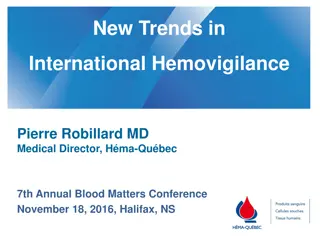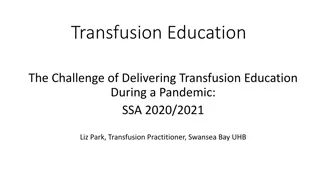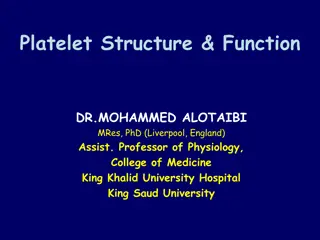Platelet Guidance: Bacterial Risk Control Strategies in Transfusion Services
Platelet transfusions carry the risk of bacterial contamination leading to severe infections and fatalities. FDA regulations mandate control strategies to mitigate this risk, such as implementing testing strategies and adhering to specific guidelines for platelet storage and handling. Understanding and implementing these measures is crucial for ensuring the safety and availability of platelets for transfusion.
Download Presentation

Please find below an Image/Link to download the presentation.
The content on the website is provided AS IS for your information and personal use only. It may not be sold, licensed, or shared on other websites without obtaining consent from the author.If you encounter any issues during the download, it is possible that the publisher has removed the file from their server.
You are allowed to download the files provided on this website for personal or commercial use, subject to the condition that they are used lawfully. All files are the property of their respective owners.
The content on the website is provided AS IS for your information and personal use only. It may not be sold, licensed, or shared on other websites without obtaining consent from the author.
E N D
Presentation Transcript
Platelet Guidance Bacterial Risk Control Strategies Christine Hayes, COO/VP of Operations Abby Huntrods, Director of Hospital Services Rachael Muhs, Technical Services Supervisor Dr. Alex Smith, Medical Director
Background Platelet Transfusion Bacterial Risk Room Temp platelets associated with higher sepsis risk and related fatalities Bacterial contamination of platelets is leading infection risk from transfusions Depending on the source and surveillance method, there are about 1/10,000 to 1/100,000 transfusion-transmitted infections per year from platelets. Evidence of 1 in 6,000 products suspected to have infectious agent The highest risk of a transfusion-transmitted infection occurs in platelets that are at days 4 to 5 of their shelf life, with 95 to 100% of septic transfusion reactions occurring on these days, and 100% of fatalities in the same range. Risk has continued with implementation of single culture 24 hours
Food and Drug Administration (FDA) PlateletBacterialGuidance FDA has established regulations to address the control of bacterial contamination of platelets. Under 21 CFR 606.145(a), blood establishments and transfusion services must assure that the risk of bacterial contamination of platelets is adequately controlled using FDA approved or cleared devices, or other adequate and appropriate methods found acceptable for this purpose by FDA. Implementation by March 31, 2021 Recommendations to control the risk of bacterial contamination applies to: Room temperature stored platelets intended for transfusion Apheresis and Whole Blood derived platelets Single Donor Platelets and Acrodose pools Platelets in plasma and preservative
Food and Drug Administration (FDA) PlateletBacterialGuidance To read the full guidance, follow link below: Bacterial Risk Control Strategies for Blood Collection Establishments and Transfusion Services to Enhance the Safety and Availability of Platelets for Transfusion
Available Testing Strategies Overview Single Step Strategies: 1. Large Volume, Delayed Sampling (LVDS) 36 hours 2. Large Volume, Delayed Sampling (LVDS) 48 hours 3. Pathogen Reduction Two-Step Strategies: Step 1: Primary Culture 24 hours or Large Volume, Delayed Sampling (LVDS) 36 hours Step 2: Secondary Culture or Secondary Rapid Testing (Verax)
Large Volume, Delayed Sampling LVDS 36 (no sooner than 36 Hours) Single culture sampled no sooner than 36 hours after collection Single-step strategy Inoculate both aerobic and anaerobic cultures Minimum sample volume 16 mL Sample each apheresis or pre-storage pool Each split from a unit should be sampled o Minimum incubation 12 hours prior to release 5 day product expiration (48 hour hold time) Can be extended beyond 5 days with 2-step strategy o
Large Volume, Delayed Sampling LVDS 36 (no sooner than 36 Hours) Advantages: Does not hold product as long as LVDS 48 Secondary testing (Verax) can be applied Lower Cost than Pathogen Reduction Applicable to Acrodose products No additional licensure submission Disadvantages: Impact to available inventory o Holds product longer than Pathogen Reduction Testing the product and not treating the product
Large Volume, Delayed Sampling LVDS 48 (no sooner than 48 Hours) Single culture sampled no sooner than 48 hours after collection Single-step strategy Inoculate both aerobic and anaerobic cultures Minimum sample volume 16 mL Sample each apheresis platelet Each split from a unit should be sampled Minimum incubation 12 hours prior to release 7 day product expiration (60 hour hold time)
Large Volume, Delayed Sampling LVDS 48 (no sooner than 48 Hours) Advantages: More likely to detect infectious agent with additional growth time Lower Cost than Pathogen Reduction 7-Day Product Disadvantages: Impact to available inventory Holds product longer than Pathogen Reduction Testing the product and not treating the product Cannot use on Acrodose Not available for secondary testing (Verax) Licensure Submission (12-Month)
Pathogen Reduction Psoralen/UVA Light Treatment Targets DNA & RNA to prevent proliferation of pathogens Replacement for primary and secondary bacterial culture screening Approved alternative to Gamma Irradiation to prevent transfusion associated graft vs. host disease Apheresis platelets Currently 5 day expiration (developing 7 day expiration)
Pathogen Reduction Psoralen/UVA Light Treatment Advantages: Product Availability Early Release, Optimal Shelf-Life Treating vs. Testing (No False Positive Product Loss) No documented Septic Transfusion Reaction Replaces Irradiation Replaces CMV testing Preparation of emerging infectious agents Possible long-term elimination of other testing (cost savings) Zika Babesia
Pathogen Reduction Psoralen/UVA Light Treatment Disadvantages: 5 Day Product (future development of 7 day) Licensure Submission Inventory Issues (Dual Inventory) Hospital Acceptance of products for varied demographics Higher Cost Associated
Secondary Rapid Testing Verax Prime Two-Step 36 hour LVDS secondary testing Extends Expiration from 5 days up to 7 days Single Donor Platelet Tested at 72 hours and 96 hours Pooled Platelet tested at 72 hours only New Product Codes *LifeServe has been using this method since October 2019
Secondary Rapid Testing Verax Prime Advantages: Extended product availability Disadvantages: Products returned for secondary testing
Comparison Overview Pathway Single Donor Single Donor Expiration Pooled Pooled Expiration License Submission 1 Step >36 Hours LVDS Yes 5 Days 48 Hour Hold Yes 5 Days 48 hour hold No 1 Step >48 Hours LVDS Yes 7 Days 60 Hour Hold No N/A Yes 2 Step >36 Hours LVDS Day 3 & 4 Yes 5 Days Tested at 72 hours & 92 Hours Yes 5 Days Tested at 72 hours No 2 Step >36 Hours Day 4 Only Yes 7 Days Tested at 92 Hours No N/A No Pathogen Reduction Yes 5 Days 24 Hour Hold No N/A Yes
LifeServe Testing Strategy Decision Combination of Single Step Strategies: 1. Large Volume, Delayed Sampling (LVDS) 36 hours 2. Large Volume, Delayed Sampling (LVDS) 48 hours Continued use to Verax for product life extension Continued investigation of Pathogen Reduction technology based on input from hospital customers
Cost Considerations All platelet product pricing will increase based on the method of additional, required testing. Cost will be added to base price of product $83 Fee for all platelet products Pathogen Reduction Anticipate increase cost of approximately $150/product *Pricing not guaranteed if imported per hospital request Your input will help us decide how and when we begin providing pathogen reduced products at LifeServe
Next Steps To follow adherence to guidance, implementation will occur no later than March 1, 2021 LifeServe License Submission for 48 hour LVDS Formal Communication will be sent with pricing changes by Nov 1, 2020 Provide new product Codes for 48 hour LVDS products Complete Survey
Questions Rachael Muhs, MLS (ASCP) LifeServe Blood Center O+ Technical Services Supervisor 431 East Locust St | Des Moines, IA 50309 Telephone: 515-309-4947 Rachael.Muhs@lifeservebloodcenter.org K. Alex Smith, DO LifeServe Blood Center B+ Medical Director 431 E Locust St | Des Moines, IA 50309 Telephone: 515.309.4872 Fax: 515.243.2880 Alex.Smith@lifeservebloodcenter.org
Pre-Presentation Survey Follow link to submit survey answers: https://app.smartsheet.com/b/form/a211f1903c7a4de4a06f6117d7d7aae6 1. Do you understand that LifeServe Blood Center is required to follow the FDA guidance to integrate these changes? 2. Are you familiar the FDA Platelet Guidance located here(link)? 3. Has your facility discussed or made decisions on your preferred strategy to adhere to the guidance? 4. Would you like additional education opportunities provided specific to Pathogen Reduction? 5. Are you concerned additional required bacterial testing will impact your access to products? 6. Will you attend webinar?
Post Presentation Survey Follow link to submit survey answers: https://app.smartsheet.com/b/form/d6e9ce428dd342838e8422d4921a65b7 1. 2. Did we answer your questions concerning the FDA s new platelet guidance? Do you believe that Pathogen Reduction provides a safer product than other bacterial detection methods? Do you believe an additional increased cost associated with Pathogen Reduction is worth the added value of treating vs testing the product? Do you believe your hospital would be interested in obtaining pathogen reduced products? Do you want additional opportunities to further discuss Pathogen Reduction? Do you have additional questions? Are you interested in educational opportunities in other topics? 3. 4. 5. 6.























